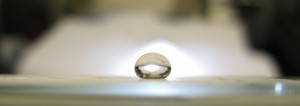IPP (Isotactic Polypropylene)
IPP acted as the superhydrophobic material for our prototype. Its synthesis involved a relatively simple solution of isotactic polypropylene in p-xylene. Heated until dissolved, the solution was dropped onto an aluminum sheet that served as our substrate. Subsequent cooling and treating with MEK as non-solvent resulted in a homogenous thin film.
The combination of a rough structure as a consequence of the selected cooling temperature, and the chemically hydrophobic composition together resulted in a superhydrophobic surface that exhibits a contact angle of 155° with water. The IPP prevents the spread of water over the surface, so that water droplets form exclusively on the superhydrophilic surface.
PPy (Polypyrrole)
PPy was used as the superhydrophilic dots spaced at regular intervals over the surface. Its synthesis involved a solution of pyrrole, ammonium persulfate (APS), oxalic acid, and HTAB. The polymerization reaction between pyrrole and APS took place in a chilled bath. The resulting solution was then centrifuged, after which the supernatant was removed and the precipitate rinsed with water. The polypyrrole precipitate in solution with water was then dropped to form a grid over the IPP coated sheet, and left heated in a furnace to remove the water.
Experiments revealed that a water droplet spreads completely over such a surface, so that the contact angle is approximately zero degrees. This effect results from the pyrrole moieties which are hydrophilic, as well roughness due the nanowire network characteristic of polypyrrole treated with the chosen chemicals.


